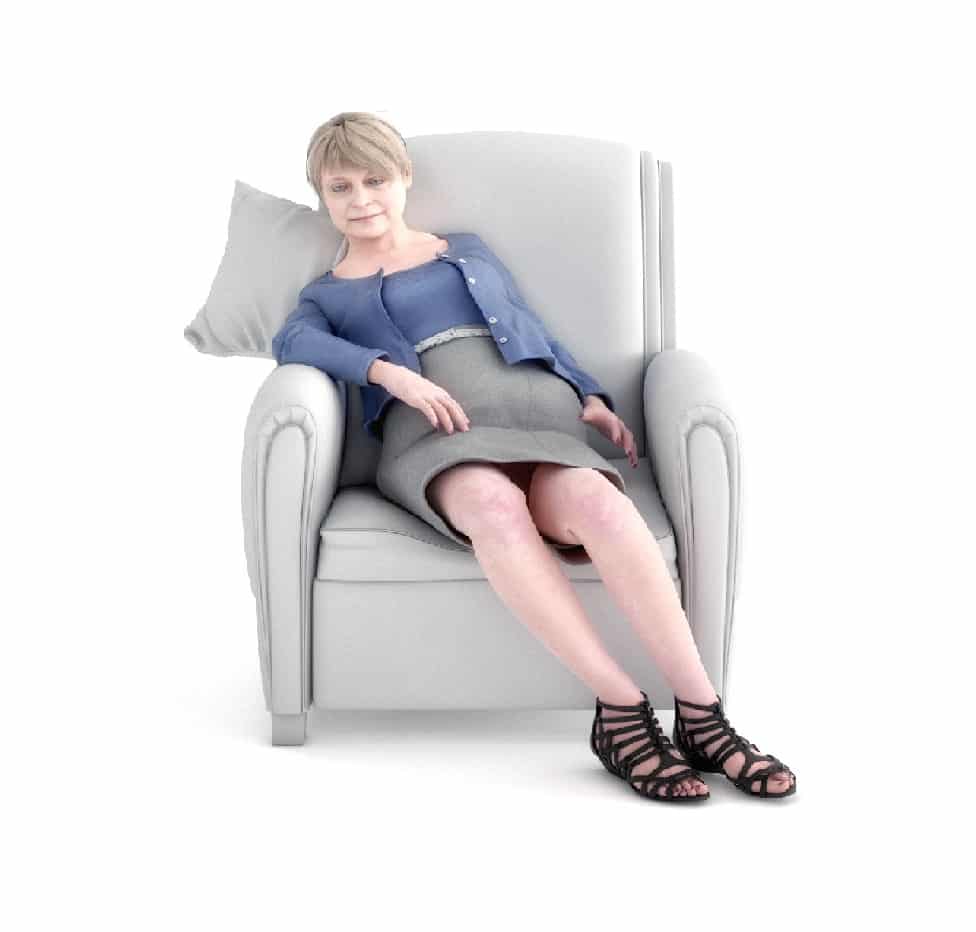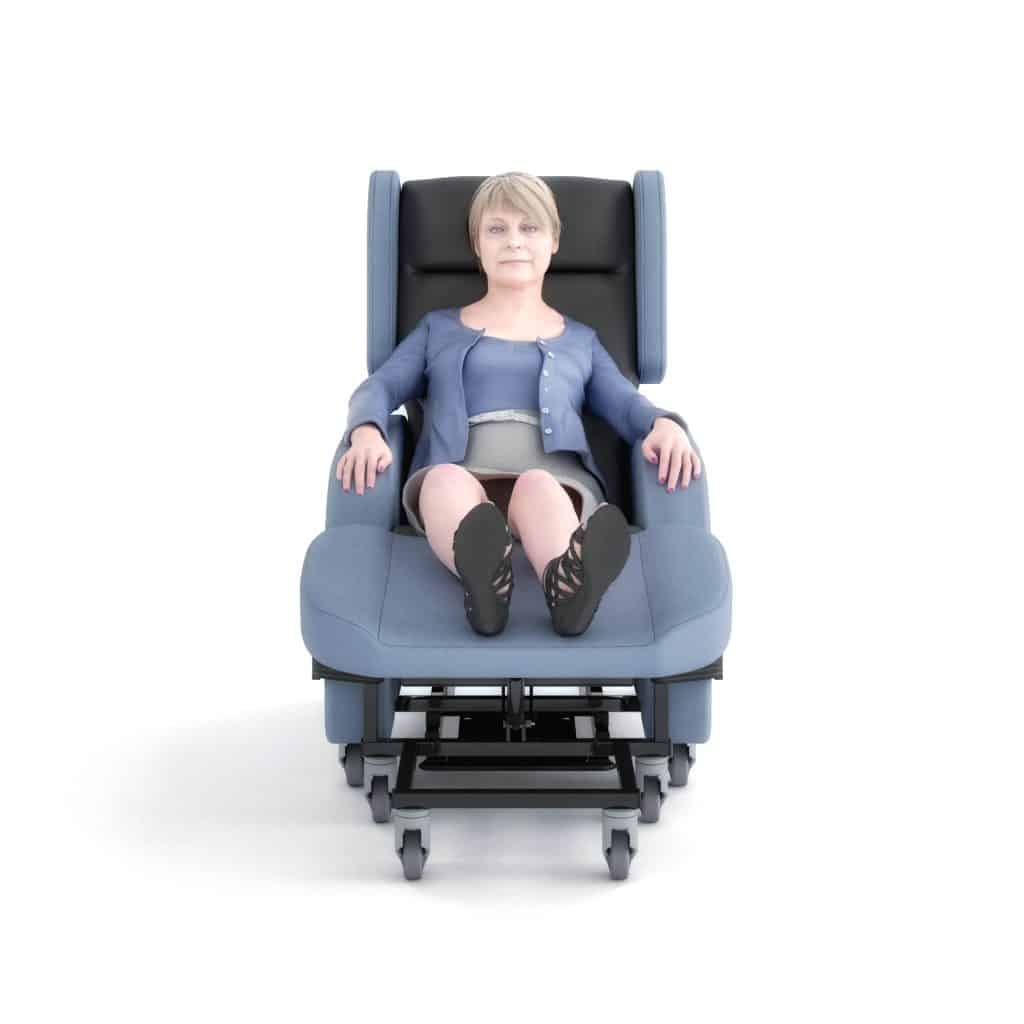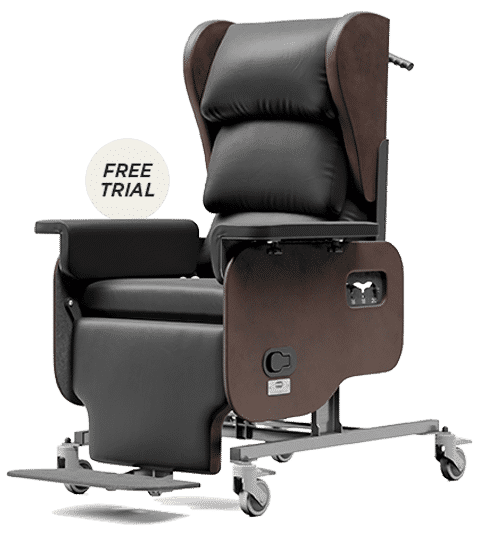Case Study (Atlanta): 81-year-old patient (Margaret) – CVA, Pressure Injury Risk
This case study is a real patient scenario. The images have been created from real photographs taken with permission. This is a real person in a real situation but illustrations have been used in order to protect their identity. Images & Content © Seating Matters 2024.
Background
- 81-year-old individual (Margaret)
- Cerebrovascular accident (CVA) (left sided weakness)
- History of pneumonia
- High risk of pressure injuries
- Developed a red area on her left heel for which she wore a pressure management boot
Problems with Old Chair
- Margaret used her original chair for approximately 6 hours per day
- She was choosing to stay in bed over sitting in her chair as she reported the chair to be unbearably uncomfortable
- Margaret would request paracetamol at night due to her pain and discomfort
This was a conflicting situation as Margaret was a very sociable person and enjoyed sitting up and spending time in different environments thorughout the home. However, due to the challenges associated with sitting, she often missed out on those activities which she enjoyed.

BEFORE
Margaret sitting in her old chair

AFTER
Margaret sitting in Atlanta™
Caregiver Issues
The caregivers found it very hard to position Margaret in her chair. Despite various attempts, they could not get her in a comfortable position and would often be aware of how much pain she felt within the chair.
The caregivers would often feel frustrated that they could not alleviate her pain. They would use pillows and rolls for positioning and comfort and would regularly correct her posture as a result.
Postural Issues
- Margaret was sitting in a right-sided pelvic obliquity and rotating to the right.
- Her feet were not loaded on the footplate and her legs were in a non-elevated position, encouraging oedema in both lower legs.
- Limited hip flexion on her affected left side which made her assume a near lying position in the chair and contributed to the deviations in her pelvis.
Intervention
After a thorough assessment, it was deemed suitable that Margaret would trial the Seating Matters Atlanta™ chair. This chair was designed specifically for her needs, with the provision of a leg rest to be used to reduce swelling on both lower limbs.
Results
Qualitative Client Feedback
Immediately Margaret expressed her satisfaction at how comfortable the chair was, and that it made a huge difference to her life. She was excited to show the staff and other residents her new chair and delighted in telling them she was now comfortable.
Postural Changes
- The leg rest was used to reduce and manage oedema in both lower legs.
- Margaret’s ischial tuberosities and pelvis were secured in a more comfortable and sustainable position.
- Margaret was able to maintain a midline position of her trunk.
- A concave head support was used when needed to support Margaret’s head in a midline position, which eliminated the need for additional pillows. Because of the breathable properties of the Dartex covering on this head support, Margaret was able to use the pillow without sweating and becoming hot, as she had done previously using towels and bed pillows.
Functional Changes
A tray table was also provided with Margaret’s chair. This encouraged bilateral hand function as she was able to use both hands or rest her left on the table, preventing weakness in her left side.
Importantly, Margaret had not required medication for pain and discomfort whilst sitting in her new chair.
Impact on Skin
- Margaret was now maximising her body contact with the support surface and distributing her weight throughout the seat, back and leg rest, all of which were made with integral pressure management materials.
- This significantly reduced any localised or concentrated pressure areas and reduced the risk of skin breakdown and pressure damage.
- The level of pressure management included in the leg rest, combined with an elevated position, ensured that the risk of breakdown on her heels was minimised.
Social Interaction
One of the most pivotal advantages of her new chair was that, for the first time since her admission, Margaret was able to attend a religious service that was being held in the nursing home. This was owing to the fact that the Atlanta™ chair could be wheeled from room to room easily. Also, Margaret was now able to sit comfortably for extended periods. In previous years, she could not tolerate sitting long enough to attend this service, which was undoubtedly very important to her.
Rachel’s story and other patient case studies are found in The Clinicians Seating Handbook. This practical guide by world-renowned OT, Martina Tierney will assist you in the prescription and use of therapeutic seating for patients with various conditions. It’s the best place to start.
*Note – the purpose of this blog is to give an overview of the product with some tips to consider on its use. This is not intended to be a substitute for professional or medical advice, diagnosis, prescription or treatment and does not constitute medical or other professional advice. For advice with your personal health or that of someone in your care, consult your doctor or appropriate medical professional.




